Dispatch from the gardens + a guide for how to make exciting salads
Don't underestimate that which appears elemental 👉🏼 Your next favorite salad, right this way, plus a gf cold noodle salad!
✴︎🌟✴︎ If you enjoy this post, thank you kindly for clicking the ♥️, restacking it, or sharing it with another foodie fan. ✴︎🌟✴︎
This is a reader-supported publication - thank you so much for being here. Upgrade for full access to the archive and make so many groan-worthy things! Dive into the complete Recipe Index, relish in beans for every season, and learn how to identify and prepare the multitude of dazzling + delicious wild foods near you. Upgrade by clicking one of the buttons below.
If something here inspires you, please leave a comment! Reading them makes my day :-) Melina
Hello! Welcome to today’s Stories from Catbird Cottage. Just the other day, I was reading this post by Ottolenghi on what makes a great salad (which - spoiler alert - was adamantly against lettuce leaves), and I was reminded of all the non-leafy salads I adore… But it is spring and lettuces are all doing their thing right now. So they’re in full rotation, filling the garden and fridge, and it is a wonderful thing. And in just a few short weeks (time is fluid and it’ll be here before you know it), those bursting-juicy ingredients will have ripened, and everything will be exploding in the garden and markets. Many exciting days ahead for cucumbers, melons, snap beans, tomatoes, corn, summer squash, and stone fruits! And without question the bean salads of summer. If you have a request for me featuring any in particular here, I’d love to hear about it in the comments.
I am particular about the lettuces I prefer to grow. If I am going to have lettuce take up room in the limited real estate of my raised beds, it needs to either be punchy - like mustard greens or arugula - or assertively crunchy-juicy in its texture, such as romaine or gem lettuce. That said, I am not one to turn down the offer of surplus lettuce from neighbors, and recently was a lucky beneficiary of “too much lettuce”. The perks of bounty during the growing season!
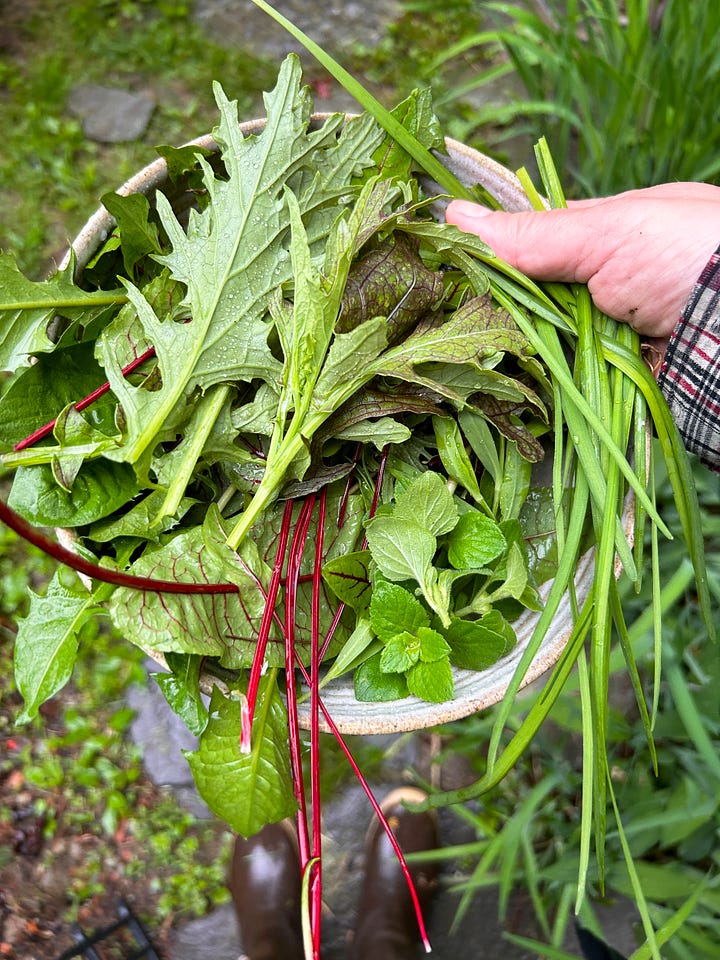
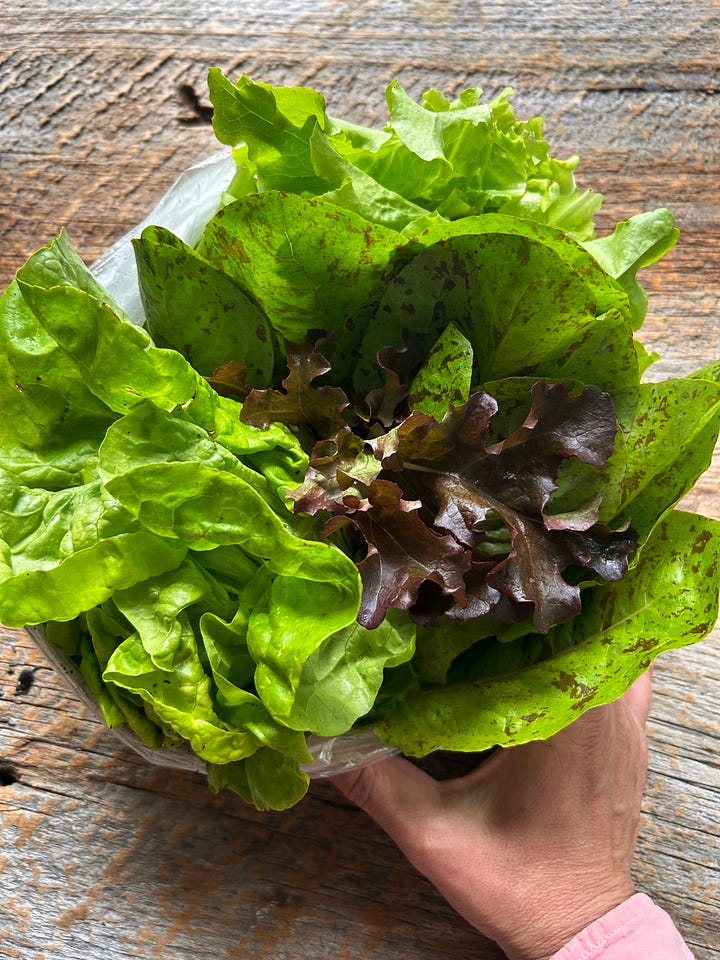
The way I make these delicate leaves dynamic is either: searing or wilting them in the pan, or by creating salads using the below guidelines, to ensure every single bite is an explosion of flavor.
But first things first.
Before the warm weather ushers in the next wave of blooms and veggies, here are some highlights from (the very wet) spring here at Catbird Cottage…
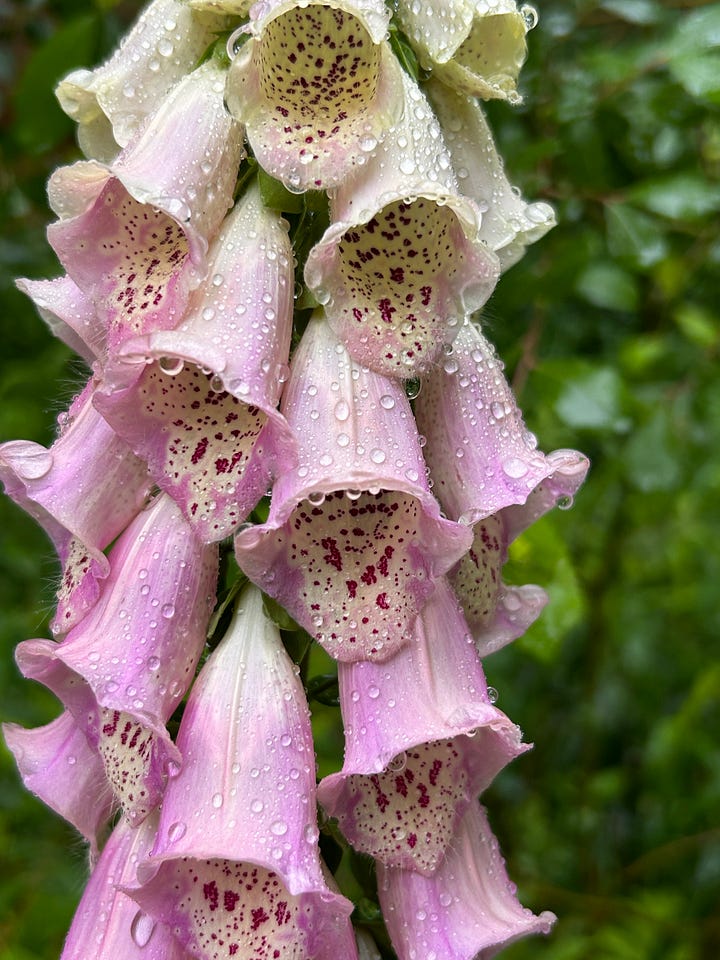
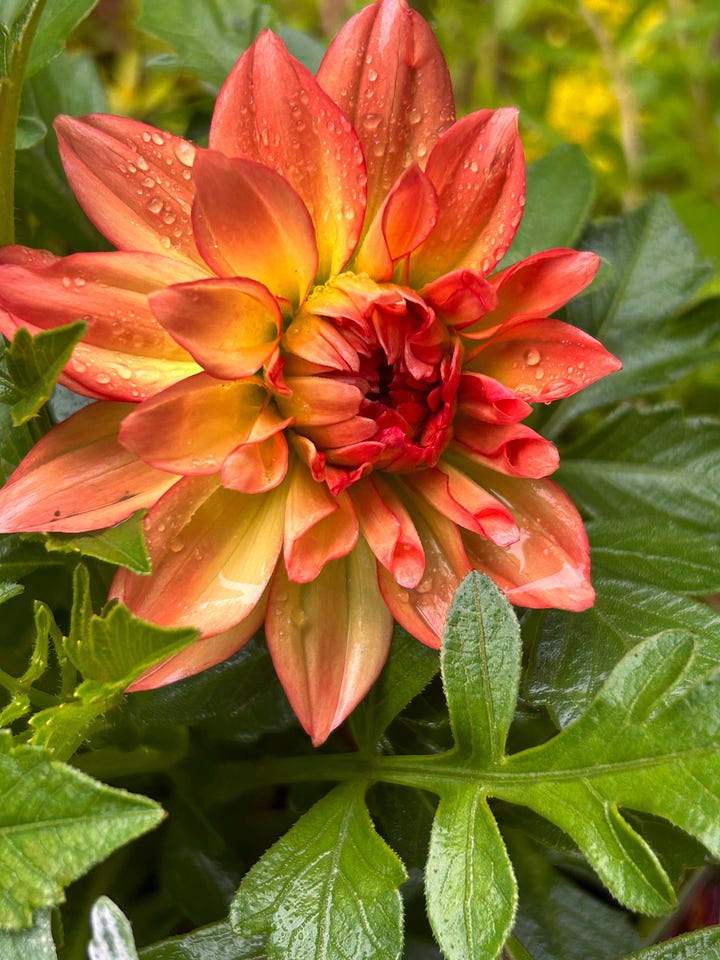
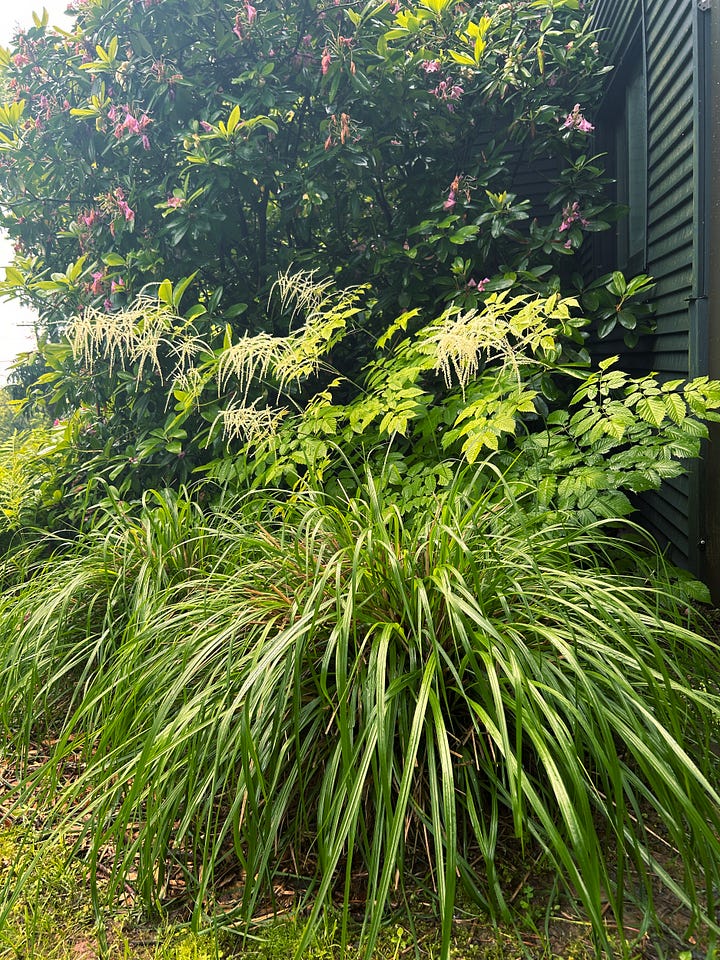
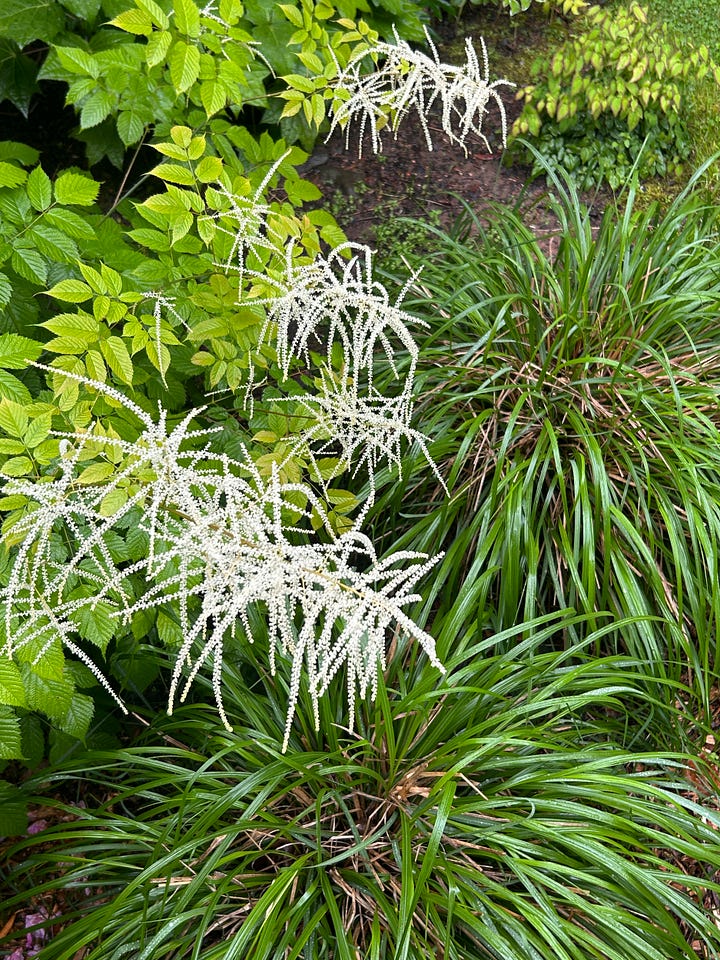
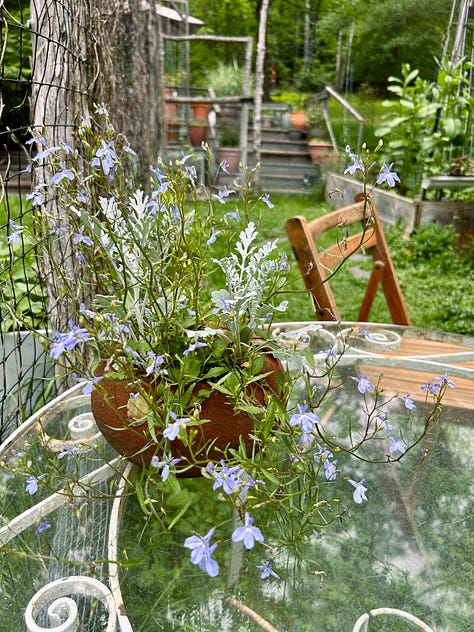
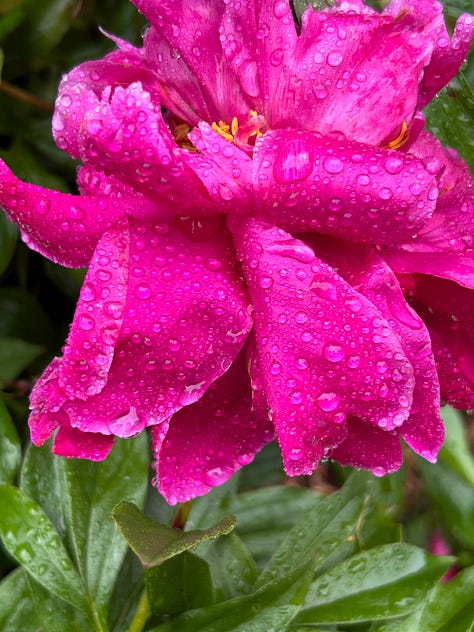
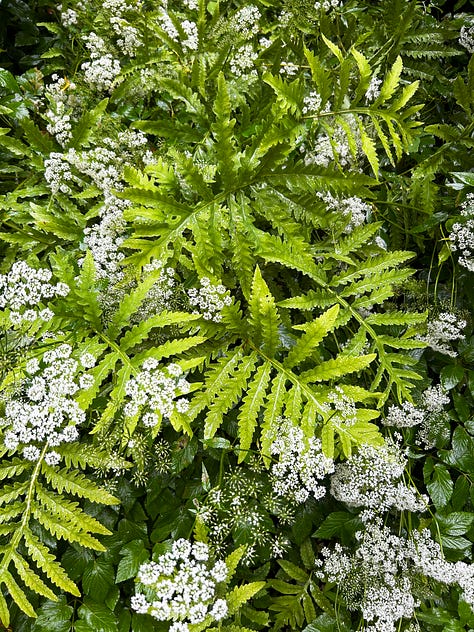
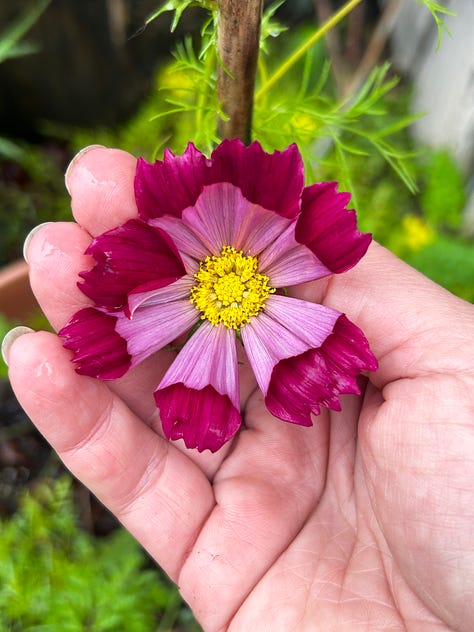

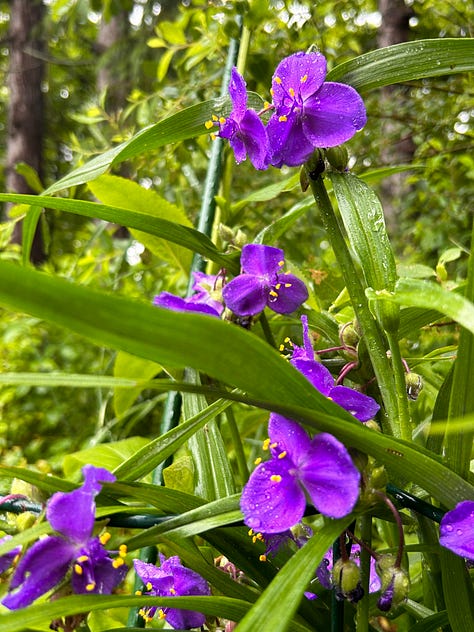
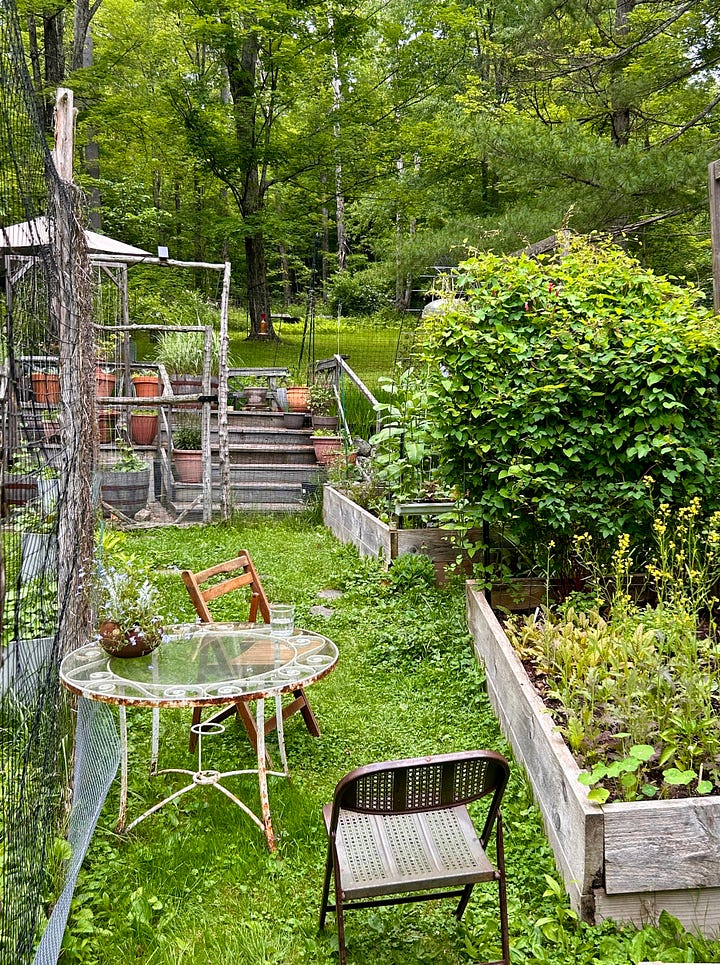
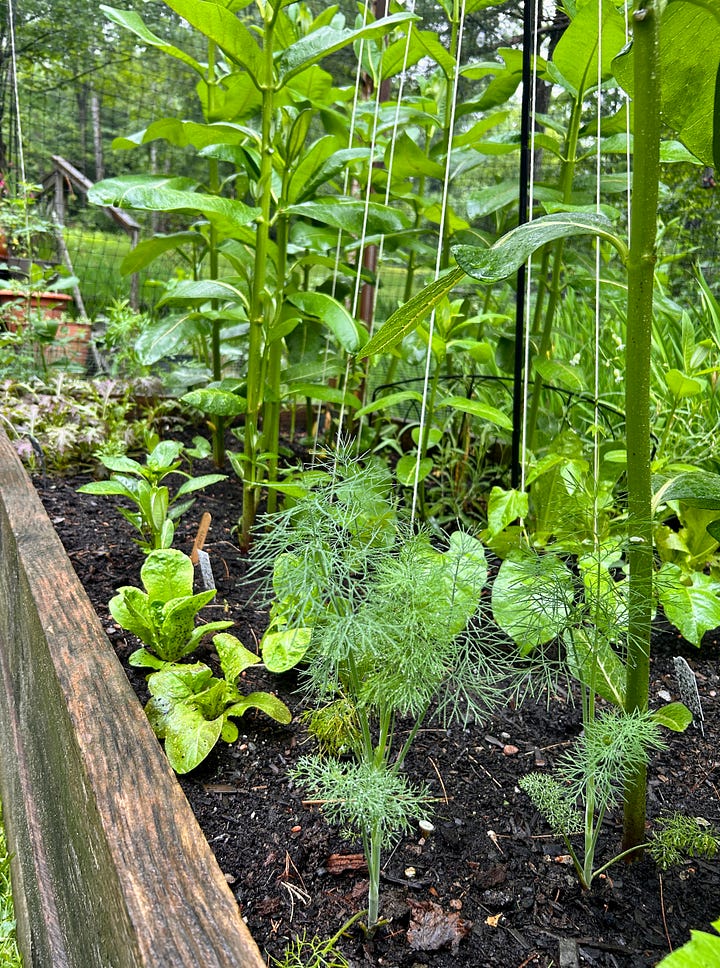
Here is a guide I hope will shed new light, so you can make your next favorite leafy salad…
Herbs add brightness and oomph
Never overlook the transformative power of a handful of tender herbs. I always add herbs, to well, basically everything. It brings surprise to otherwise simple fare, and the added colors and textures dazzle the eyes before we eat.
regular or purple shiso, or lemon balm for floral minty character (and more color)
mint (spearmint, peppermint, apple mint), lemon balm, calamintha - each will brighten rich or mild foods… taste and add one or a couple varieties in the mix with other herbs
sweet basil, Thai basil, opal basil - each varies in offering more fruity, floral, or sharp notes, and all are delicious
chervil, for its soft anise quality and even softer frondy texture
parsley, cilantro, or dill - use them as you would salad greens, aka in abundance
tarragon, sculpit, both of which have a soft anise character, and the latter, an Italian herb, with a hint of bitterness akin to radicchio
ground elder - use tender leaves or flowers for celery-meets-lovage notes
oregano or monarda leaves, for peppery nuance
Add flowers
Flowers = beauty. Many are also edible. Flowers are a plant’s means to woo pollinators so they can proliferate. Bonus, the more you harvest a plant’s flowers, the more the plant will race to keep up and produce more of them in an effort to successfully set seeds.
There is no end to the value in eating flowers: harvesting them is
the most of-the-moment eating… and, flowers are delicious unto themselves.
We’re literally eating ephemera - who doesn’t want to bask in that?
Plus, eating beauty fills the soul.
nasturtium flowers may be the most well-known - they are famous for their bold appearance and sweet, peppery heat
mustard and arugula flowers impart cheery color and a little peppery hit
chive blossoms, so delicate in appearance, deliver an oniony *burst*
calendula, bachelor button, and pansy petals are mild, but their beauty is a bona fide mood-lifter
pea flowers are sweet and beguiling
bee balm petals - especially wild bergamot, monarda fistulosa - bring peppery spice
borage is stunning for its blue hue and pairs excellently with seafood dishes, thanks to its oyster-like notes
ground elder umbels can be separated from the stem - each little flower cluster channels celery or lovage
Make a seemingly simple green salad and transform it from ho-hum to *goddamn* with herbs and edible flowers.
If access to these ingredients is beyond reach, don’t worry. You can find bliss just by mixing your own vinaigrette, and the options are endless.
Make a vinaigrette with big flavor
Making a dressing can take just 5 minutes and the variations are infinite. With a foundation of oil, vinegar, an allium, salt and pepper - and sometimes mustard - you have the makings of a fantastic vinaigrette that is both bracing and lush, coating all those tender leaves. Expand the “dressing” box by incorporating any (or multiple) of these punchy elements, in proportions that bring balance to the whole.
use chopped pickled red onions (and their brine) for a quick, dynamic vinaigrette
add preserved lemon flesh and blitz it in a blender or mince it into a paste to add fantastic salty-lemony depth
use chopped pickles of any kind and their brine - from cornichons to carrots, okra, to green beans - these pickley layers punch-up the flavors and produce a salad you’ll lust after
try capers - or chopped caper berries or olives - to bring new depth to your vinaigrette
add the pickled seeds from the bottom of the jar, such as mustard, coriander, or fennel seeds for nuance and *pop*
use grain mustard to add more texture, similar to the pickled seeds
reach for a new vinegar for new results (this is easy if you keep a well-stocked pantry)… Try ume plum vinegar, sherry vinegar, or champagne vinegar for brighter or deeper flavor and new, interesting character
add lemon or orange juice and its finely grated zest to take a salad in a brightly citrusy direction
use shallots, garlic chives, regular chives, scallions, field garlic, roasted garlic, garlic confit, or garlic scapes to redefine the character of your vinaigrette - while alliums all impart bold flavor, each has a different personality. Garlic confit or roasted garlic bring a sweeter, buttery garlic quality, whereas chives and garlic chives are bright little zaps of allium, and scallions impart that green *slap*. I swear any of these, in proper proportion and emulsified into velvety dressing, can woo even those who “don’t like salad”…
add an accent of another flavor power player, such as minced ginger, chopped anchovies, a drizzle of fish sauce, freshly grated horseradish, a small spoonful of marmite, or shrimp or tamarind paste
of course you can add mayonnaise, tahini, or an egg before blitzing your vinaigrette to get a salad real dolled-up. This installment, however, is about extracting the thrills from delicate-seeming or inconsequential elements to create a riveting symphony. Unadulterated salady magic…
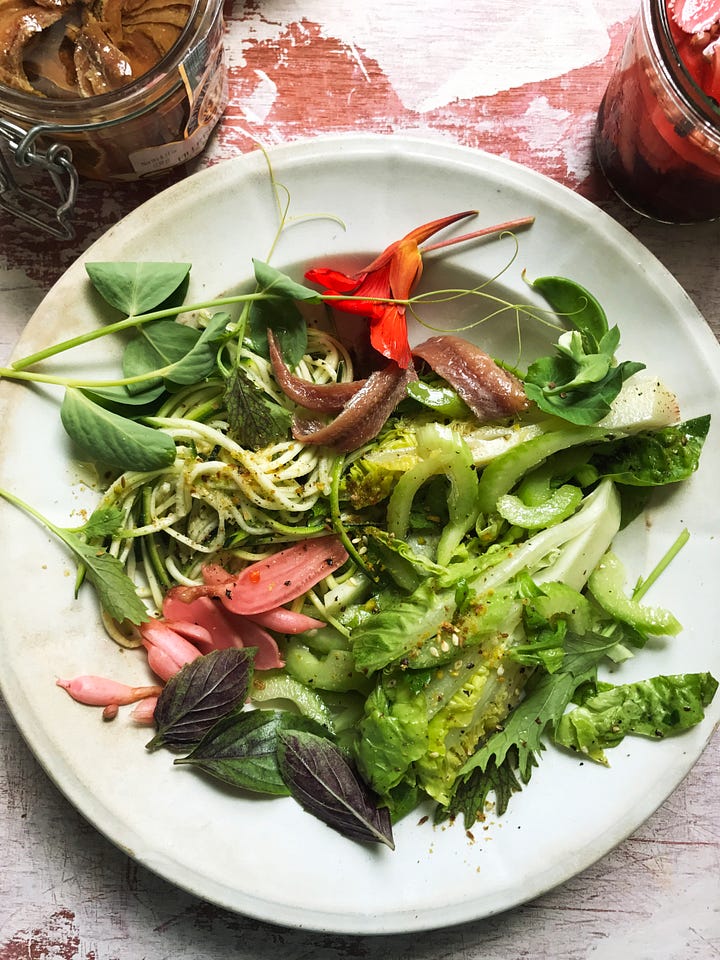
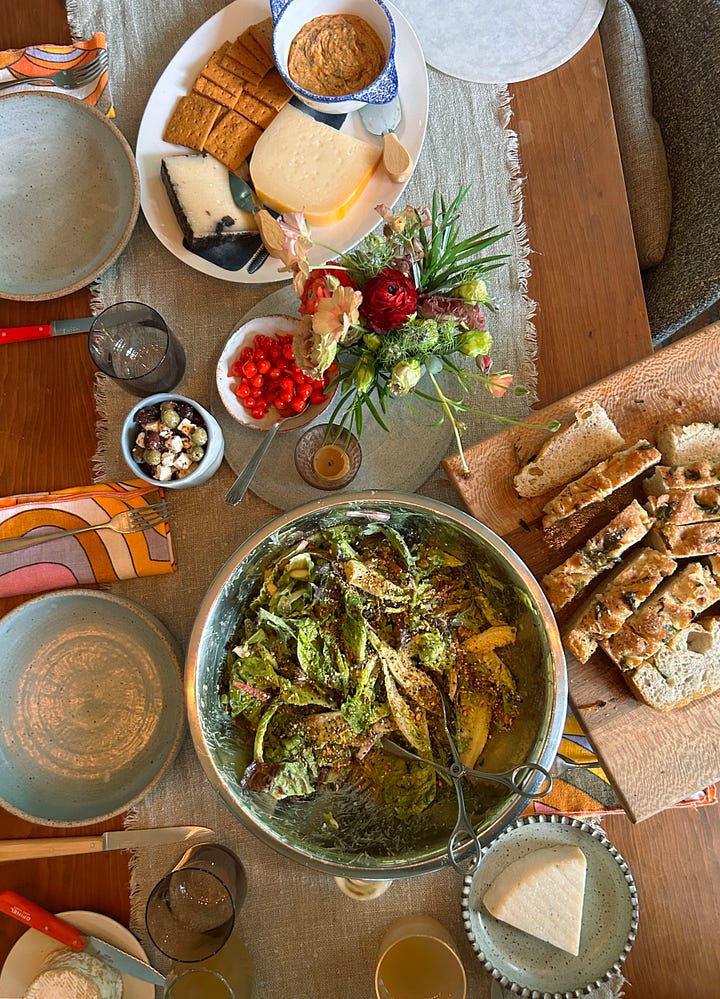
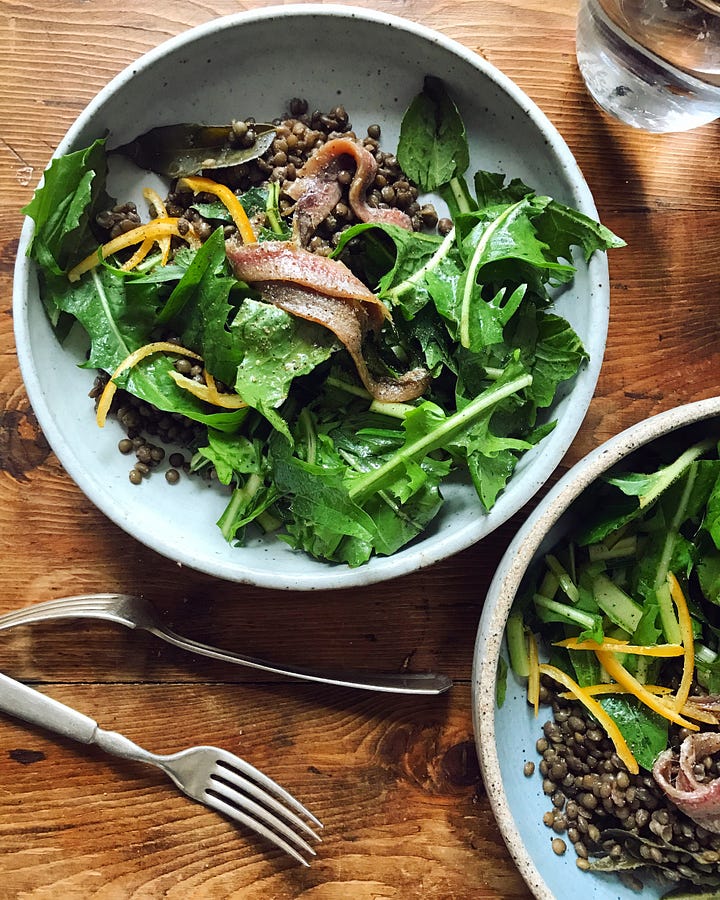
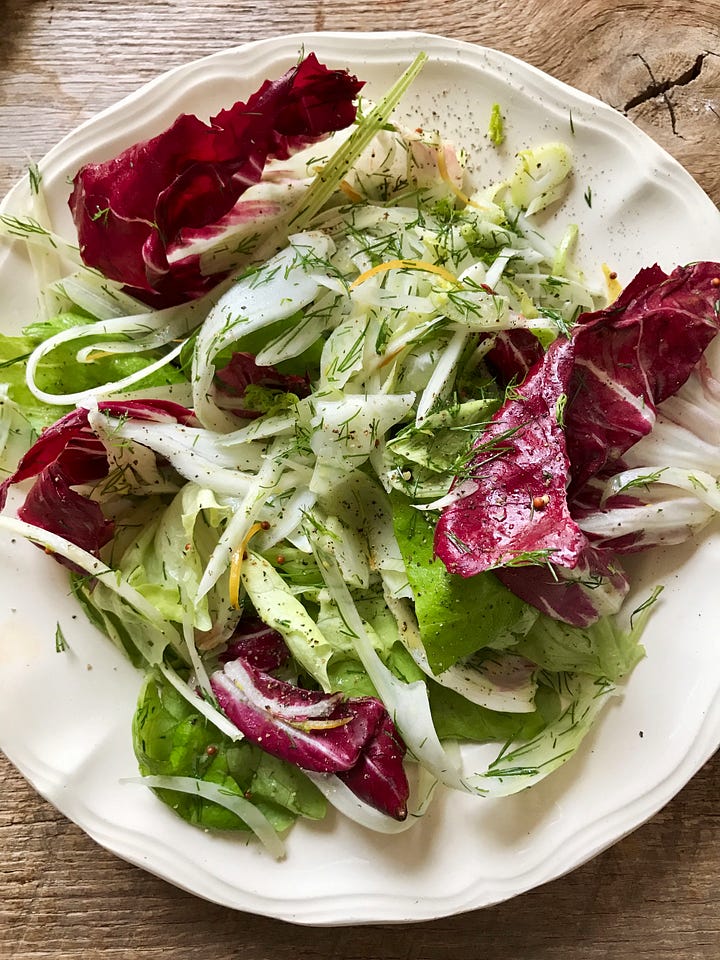
Taking a cue from these guidelines is this terrific cold noodle salad. It offers refreshment on hot days and is versatile, so use what you have in your own kitchen.
Bright + refreshing cold noodle salad
In-kind with the above, this is more a guide than a recipe. The extra benefit of this dish is that the elements can all be prepared in advance, then thrown together last-minute. Dress the pasta and keep it room temperature if you make the elements in advance.
Serves 4-6
1 package noodles, such as soba, bean thread, or linguine
toasted sesame oil, for drizzling
sauce
2-3 tbsp toasted sesame oil
1 tbsp fish sauce
1 tsp soy sauce
1 tbsp pickle brine
1 tbsp fresh lime juice
choose up to four
3 cups, thinly sliced - a mixture -
radishes
summer squash
green beans, sliced into little coins
Persian or kirby cucumbers
yellow or red bell pepper
asparagus, woody ends snapped off
snap peas, fibrous seams removed
green papaya or mango, sliced into very thin longish strips
steamed broccoli florets
choose one
1 1/2 - 2 cups -
sautéed mushrooms (button, shiitake, beech, cremini, and oyster all work well)
poached or seared fish, such as salmon or halibut, flaked into pieces
poached or roasted chicken, shredded
cubed, roasted tofu
choose 2 from each line
2-3 tbsp each of these pickley things, very thinly sliced -
pickled red onions, jalapeño pepper, ginger
pickled radishes, carrots, summer squash, cornichons, etc
choose two
1/2 cup leaves each, or more -
cilantro
mint
parsley
basil
shiso
alliums for garnishing, choose one
garlic scapes, very thinly sliced
chives, finely sliced
chive blossoms
Cook pasta al dente according to package instructions and drain. Transfer the noodles to a large bowl and drizzle lightly with sesame oil. Use tongs to gently toss the noodles with the oil, lightly coating the strands to prevent them from clumping.
When the noodles are cool enough to handle, add the fish and soy sauces, lime juice, and brine, then toss again. Use your hands to gently separate any remaining clumps, should you find them.
Chop the crunchy elements: If using radish, slice it thinly on a mandoline to create delicate disks. Thinly slice raw asparagus on a diagonal. If you use any fresh snap bean, they do not need to be cooked and can be sliced straight away into thin coins.
Combine everything else except the reserved herbs and alliums for garnish into the bowl and gently toss to incorporate. Taste and adjust seasoning as needed.
Transfer the noodle salad to a serving platter. Scatter with alliums and shower with fresh herbs. Eat at once.
🌟🌟Thanks kindly for giving a ♥️ to this, on the top left or bottom of this post. It very much helps spread the word!🌟🌟
Stay in touch -
Follow me on Instagram.
Do you love A Year at Catbird Cottage? If so, thanks so much for leaving a review on Amazon, whether you purchased it there or not. It makes it easier for others to find my book. Thank you!
Catbird Cottage is our home in the Hudson Valley, NY, where I teach cooking and gardening workshops, and host intimate dinners guided by the seasons. Drop a line to reserve a special meal or a delicious workshop with your friends.
My website contains a free recipe archive through the years, featuring fresh, seasonal ingredients that always bring wow to the table.
Enjoy my newsletter? Please forward it to a friend who might enjoy it too.

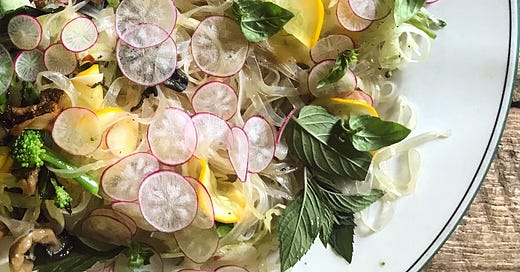








this is a great panoply of choices for regular salads and dressings, not to mention the pasta salad. So easy. And I havesome of these in my garden that I can put to this newly divulged use!